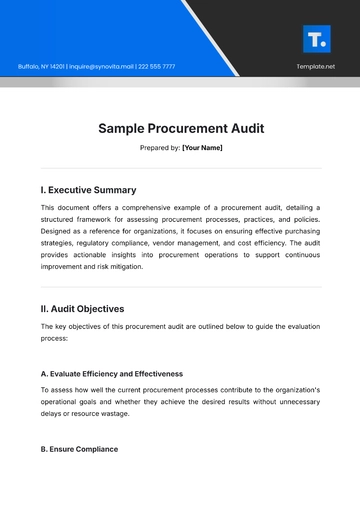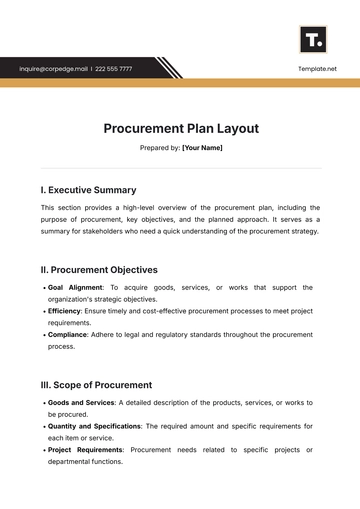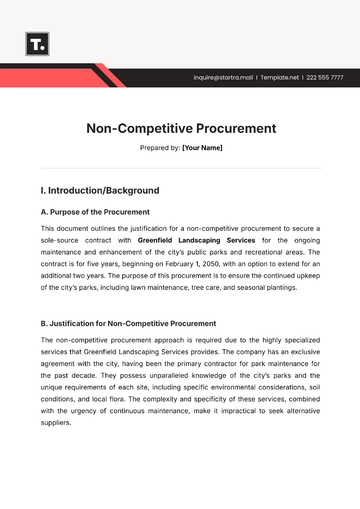Free Procurement Compliance

Prepared by: [Your Name]
I. Introduction
Procurement compliance is a critical function in any organization, ensuring that the process of acquiring goods and services adheres to legal, regulatory, and ethical standards. It ensures that procurement decisions are transparent, responsible, and in the best interest of the organization while maintaining fairness and integrity. Adherence to procurement compliance reduces risks related to fraud, corruption, inefficiency, and non-compliance with legal or organizational standards. This document outlines the essential aspects of procurement compliance, including policies, procedures, and risk management strategies to guide procurement operations through 2050 and beyond.
II. Legal and Regulatory Framework
A. Relevant Laws and Regulations
Procurement compliance is governed by a variety of laws and regulations that organizations must follow to ensure fair and transparent operations. These laws are subject to changes and updates over time, which is why procurement officers must stay informed of new regulations. Key legal frameworks include:
Public Procurement Regulations (2050 Update): This set of laws governs procurement within government agencies and other public institutions. In 2050, regulations emphasize sustainability and ethical sourcing, ensuring that taxpayers' money is spent efficiently and transparently.
Anti-corruption Laws: Stricter anti-bribery and anti-corruption laws are enforced globally, requiring organizations to ensure that procurement processes are free from influence and bribery. This is especially relevant as the global economic landscape evolves in 2050.
Environmental Regulations: Governments and international bodies now enforce more robust environmental standards. Procurement officers must consider the environmental impact of products and services, aiming for sustainable sourcing and minimizing carbon footprints. This includes compliance with climate policies and international agreements on reducing global emissions.
Labor Laws: With a growing global workforce, procurement compliance in 2050 focuses on ensuring that suppliers and contractors adhere to fair labor practices, preventing exploitative working conditions or violations of workers' rights.
B. International Standards
International procurement standards play a significant role in global trade. Organizations must comply with international procurement guidelines, which include:
ISO 20400: This standard offers guidelines for sustainable procurement practices. By 2050, ISO 20400 has evolved to incorporate deeper considerations of social responsibility, climate change, and circular economy principles, offering businesses the framework to procure responsibly.
World Trade Organization (WTO) Agreements: As global trade has expanded, organizations are increasingly engaging with international suppliers. WTO agreements establish procurement rules that ensure fair competition and non-discriminatory practices, with a focus on reducing trade barriers.
III. Procurement Policies
A. Ethical Procurement
Ethical procurement practices are a cornerstone of compliance. These practices ensure that every procurement decision is made impartially, without any undue influence or conflict of interest. Key practices include:
Fairness and Transparency: Procurement decisions should be based on objective criteria such as cost, quality, and sustainability. For instance, in 2050, organizations are required to disclose detailed reports of procurement processes to the public to promote transparency.
Conflict of Interest: Employees involved in the procurement process must avoid any situations where personal interests could conflict with the organization's objectives. A strict policy is in place to disclose personal relationships with vendors, as such conflicts can lead to unethical decisions and legal risks.
B. Supplier Selection and Evaluation
The selection of suppliers is a critical aspect of procurement compliance. Organizations must ensure that suppliers are evaluated fairly based on pre-established criteria. These criteria should evolve to include sustainability, ethical standards, and future-proof practices:
Objective Evaluation Criteria: Organizations must establish clear guidelines for supplier evaluation. This includes pricing, delivery schedules, and adherence to regulatory standards. By 2050, there is a growing emphasis on evaluating suppliers based on their environmental practices, such as carbon emissions, waste reduction, and resource management.
Performance Monitoring: Regular assessments of suppliers' performance, including quality of service, timeliness, and ethical practices, help maintain compliance. Vendor performance reviews are essential to ensure that they continue to meet contractual obligations and compliance standards over time.
C. Contract Management
Proper contract management is essential to ensure that procurement activities remain compliant with both legal requirements and organizational policies:
Clear Terms and Conditions: Every procurement contract should outline the responsibilities and obligations of all parties involved. As of 2050, contracts include clauses that emphasize sustainability, ethical labor practices, and the use of renewable resources.
Contract Monitoring: Contract compliance must be regularly monitored to ensure adherence to terms and conditions. This includes reviewing delivery performance, payment schedules, and compliance with legal regulations. As compliance becomes more complex, specialized teams and automated tools are now used to track compliance in real-time.
IV. Compliance Procedures
A. Procurement Planning
Effective procurement planning is critical to ensuring compliance. A procurement plan outlines the process for acquiring goods and services, ensuring it meets organizational goals and complies with regulations:
Compliance Roadmap: A procurement roadmap should identify compliance checkpoints throughout the procurement lifecycle. This includes regulatory requirements, budget approvals, supplier contracts, and post-purchase reviews. By 2050, many organizations implement real-time monitoring systems that track compliance throughout every phase.
Sustainability Goals: Procurement plans must align with an organization's broader sustainability and corporate social responsibility (CSR) goals. This could involve selecting suppliers who demonstrate a commitment to green practices or aligning the plan with the organization’s long-term goals for reducing environmental impact.
B. Vendor Audits
Regular vendor audits are a cornerstone of procurement compliance, ensuring that suppliers adhere to the agreed-upon standards and legal obligations:
Comprehensive Audit Programs: Procurement teams should conduct both scheduled and random audits of vendor performance to ensure that they remain compliant. These audits assess factors like timely delivery, product quality, and adherence to ethical labor practices.
Audit Reporting: The results of vendor audits should be documented thoroughly. Organizations must take action based on audit findings, such as renegotiating contracts or terminating relationships with non-compliant suppliers. In 2050, audit reporting will be more transparent, and often accessible by both internal and external stakeholders for greater accountability.
C. Documentation and Record-Keeping
Proper documentation and record-keeping are essential for demonstrating compliance and supporting audits:
Comprehensive Records: Every procurement decision, from the selection of suppliers to the final contract signing, should be documented. These records should include email communications, invoices, purchase orders, and any legal documents. By 2050, many organizations utilize blockchain technology to ensure that procurement records are secure, traceable, and tamper-proof.
Long-Term Record Retention: Organizations must adhere to record retention policies, which are often dictated by regulatory bodies. In 2050, the trend is toward maintaining records indefinitely in a digital, secure format, ensuring that organizations are prepared for audits or legal reviews years after the procurement transaction occurs.
V. Risk Management
A. Identification of Procurement Risks
The first step in risk management is identifying potential risks that may impact procurement compliance. These risks are not static and evolve:
Emerging Risks: New types of risks have emerged as organizations face greater pressures related to environmental, social, and governance (ESG) considerations. For instance, there is a growing risk associated with poor environmental practices by suppliers or non-compliance with human rights standards in global supply chains.
Economic and Geopolitical Risks: As organizations become more global in 2050, geopolitical events and economic instability can present procurement risks. Natural disasters, trade wars, and supply chain disruptions could impact the ability to maintain compliant procurement practices.
B. Mitigation Strategies
Once risks are identified, organizations must implement strategies to mitigate those risks:
Due Diligence: Conduct thorough due diligence before entering into contracts with suppliers. This includes reviewing financial stability, reputation, and compliance with legal standards. In 2050, due diligence will be increasingly automated and include scanning suppliers for alignment with international ESG standards.
Contingency Planning: Develop contingency plans that outline steps to address procurement disruptions. This could involve identifying backup suppliers, creating buffer stocks, or ensuring that contracts contain clauses for unexpected delays.
C. Supplier Risk Assessments
Ongoing assessments of suppliers’ performance and risks are essential to maintaining procurement compliance:
Performance Reviews: Regularly assess supplier performance to ensure that they continue to meet compliance standards, including ethical and sustainability criteria.
Risk-Based Selection: By 2050, organizations will incorporate risk-based supplier selection, ensuring that the most critical suppliers—those providing high-risk products or services—are thoroughly vetted for compliance.
VI. Audit and Monitoring
A. Internal Audits
Internal audits are crucial for identifying any procurement non-compliance before it becomes a significant issue:
Internal Audit Reviews: Perform regular internal audits of procurement processes, looking for inefficiencies, fraud, or violations of internal policies. These audits can now be enhanced using predictive analytics to identify anomalies or trends that could indicate non-compliance.
B. External Audits
External audits provide an independent review of procurement activities and offer an unbiased perspective:
Independent Audit Engagement: Engage third-party auditors who specialize in procurement compliance to review operations and ensure that they adhere to all legal, ethical, and regulatory standards.
C. Monitoring Compliance
Continuous monitoring is vital for maintaining procurement compliance:
Automated Monitoring Tools: In 2050, real-time monitoring tools using AI and data analytics will be employed to ensure procurement processes remain in compliance at every stage. These tools can flag non-compliance risks, enabling quick corrective action.
VII. Enforcement and Penalties
A. Consequences for Non-Compliance
To ensure the integrity of procurement activities, there must be strict consequences for non-compliance:
Disciplinary Actions: Employees found violating procurement policies may face disciplinary actions such as fines, suspension, or termination. The organization is committed to enforcing these actions to uphold its procurement standards.
B. Reporting Mechanisms
A transparent and accessible reporting system is necessary for compliance:
Whistleblower Protections: Establish confidential channels for employees, contractors, or suppliers to report any violations of procurement policies without fear of retaliation.
C. Corrective Actions
Upon identifying non-compliance, organizations must take immediate corrective actions:
Revised Procurement Procedures: If an issue arises, corrective measures should include revising procurement procedures, retraining staff, or replacing non-compliant suppliers.
VIII. Conclusion
Procurement compliance is a continuously evolving process, with new laws, technologies, and global trends shaping procurement practices into 2050 and beyond. As organizations navigate the complexities of procurement, maintaining adherence to legal, ethical, and regulatory standards is more critical than ever. By focusing on transparency, accountability, and sustainability, businesses can ensure that their procurement operations are both effective and compliant, minimizing risks while fostering long-term success.
- 100% Customizable, free editor
- Access 1 Million+ Templates, photo’s & graphics
- Download or share as a template
- Click and replace photos, graphics, text, backgrounds
- Resize, crop, AI write & more
- Access advanced editor
Ensure compliance in every procurement process with Template.net’s Procurement Compliance Template. This fully editable and customizable template provides a framework for adhering to procurement regulations and policies. Use our AI Editor Tool to make adjustments quickly and align the template with your specific compliance requirements. Template.net ensures that you stay on top of regulatory standards.





























